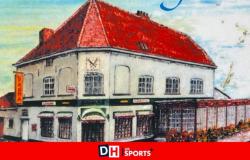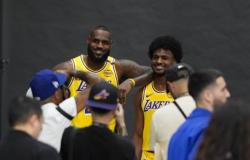In “The Exploits of Connie Mara”, he imagines a heroine meeting her creators in the real world. An opportunity for the children’s author to question the concept of hero. And to talk to readers about writing.

As a child, Jean-Philippe Arrou-Vignod devoured the adventures of the Club des Cinq, secret agent Langelot, Fantômette and Alice… Which inspired him to create the character of Connie Mara. Photo Chloe Vollmer-Lo
By Raphaële Botte
Published on September 27, 2024 at 8:00 a.m.
Dyears The Exploits of Connie Mara, the writer and editor Jean-Philippe Arrou-Vignod (The Stories of Jean-Something, College survey or even Olympe de Roquedor, co-written with François Place…) features a novelist and her character. The adventure is coupled with a clever reflection on writing and the place of heroes.
In your novel, one of your characters, Alicia Grant, writes a series of children’s novels with her children in which Connie Mara is the heroine. Did you imagine it as a sort of archetype of children’s literature?
It is rather the resurgence of an old link that I have with the characters of childhood literature that I passionately loved: these boys who had adventures in The Club of Five, Langelot secret agent…, and these girls whose adventures I devoured, Fantômette, Alice or the Parker sisters. I wanted to pay homage to this fairly popular, somewhat empathetic literature, where the villains have sinister faces, where the heroes have extreme temperaments and all the talents. I wanted these characters to be incarnated to meet their readers and, better yet, their creator!
Read the review
r “The Exploits of Connie Mara”, a backfiring novel where the heroine comes to the aid of… its author
Why not have written a series directly in this vein? (The Club of Five, Fantômette…) with a somewhat perfect heroine?
To create a contrast with our times. In this somewhat dated literature, there is a fairly innocent relationship with the world. The mysteries are solved simply, the villains are shoddy villains… This fairly gentle world but with characters of character dazzled me when I was a child. Imagining how this would be received in this day and age is fun. It’s true, I could have written the adventures of such a hero directly, but could we write today with the same naivety? Today’s young readers have such knowledge of the ugliness of this world, of what violence, bad guys really are…
Do you think it is important to offer young readers characters in tune with today’s world?
For this novel, in any case, I thought we had to have fun with the contrast between this literature of yesteryear and our world (Alicia Grant and her children, a small modern family, well in its time and dialogues contemporaries). It’s funny to play on these two tones: there is Connie Mara, perfect heroine, 13-year-old detective, character of the novelist Alicia Grant, and Connie Mara coming out of the book and interfering in a present-day plot . I focused on what could become interesting about this heroine in the real world: this little starlet who is so used to having everything succeed and everyone admiring her is, in the end, full of herself. and a little superficial. But above all, she is fed up with all these adventures and she would like to be an ordinary young girl, experiencing more peaceful things instead of constantly being confronted with problems.
Also read:
Jean-Philippe Arrou-Vignod: “As a child, I loved enjoying this state of inhabited solitude that reading provides”
Ultimately, wouldn’t the “ideal” heroine be a character bringing together all these facets?
Certainly. In this literature of yesteryear, the characters are so whole and stereotypical that we don’t really get attached to them. I started really liking Connie when she came out of the book, when she became infuriating and brilliant. Heroes are not interesting if they are just heroic: it is the individuals with their contradictions that interest us, because we recognize ourselves in them. Heroes just have this little extra thing: they are a little more insolent, a little more rebellious, a little more courageous than us, but it is still possible to aspire to be like them.
Did playing with this fictional character give you more freedom?
Yes, but I also had the porous border between these two worlds to monitor. It had to always be very clear to the reader: to know when we are in a universe and when one has rubbed off on the other. The difficulty of this story with a meta story is to give it perfect coherence. It’s complicated to create an adult writer in a children’s book: I wasn’t sure that children would be interested in it. That’s why I imagined this little tribe that writes together. I love it! Imagining the three Brontë sisters writing in the evening under the same roof has always made me dream. In this novel, this allows children to identify with the figure of the writer because even Emma, the youngest, suggests ideas. It’s a way to introduce the child to the world of writing. For me, it’s magical! I hoped to communicate that magic and show that stories don’t work like they do in real life. There are possibilities of feinting with the player, accelerations, wonderful shots.
Also read:
Ten-page novel, favoring story over style… An author’s advice to budding writers
And this allows us to question the very notion of character…
I don’t like writing to show, explain, give lessons… I like to write stories that entertain, that bring pleasure, but I found that this idea was amusing and that, moreover, it posed questions: to what extent can Do we believe in fictional characters? Do they really exist? When we read a series, we see them so much that they almost become more real than our classmates… If they existed, what would they be like?
How do you view the improbable in children’s literature? How far can you go with your character?
It’s a matter of a fiction contract to be kept with the reader: “What you are going to read, you are going to believe it. » A degree of plausibility is therefore necessary, but it is up to me, the author, to impose it. I can lead the reader to believe in completely improbable things provided I have the means to do so. The author sets his limit between what is probable and improbable. And if we are very strong, we can make completely improbable things probable! Playing with this is fun for me.
This new novel contains some elements to discover what a character is, an outcome, a narrative ellipse, the state of mind of a writer…
From the perfect heroine, Connie Mara ultimately reveals herself to be impertinent, unabashed, rebellious… What does this say about the status that an author gives to her character?
In the books, Connie Mara is steeped in a sense of justice, and in “real life”, she is quite selfish. This reflects how hero characters cannot stay in the place where they are assigned. They are always out of step with society. Connie Mara can’t just be the daughter of the Port Clam police chief as she’s portrayed, she has to run her own business! A heroine is not content to just be what we want her to be. She wants to enjoy life, have evenings with her friends… The heroes shake the little prison in which the authors lock them up. This is also the case for another of my heroines: Olympe (in Olympe de Roquedorwritten with François Place). She is a hero because she does not want to become what she is ordered to be.
You were a professor, then now an editor and author. To what extent do writing tips also creep into this novel?
These are not really tips, but I want to communicate about what writing is, both for adults – I actually wrote Do you write? The novel of writing – only for children. It is true that this new novel contains some elements to discover what a character is, an outcome, a narrative ellipse, the state of mind of a writer… It is a way of offering young readers an opportunity to enter into this universe. Is this the teacher speaking? The editor? I don’t know. The world of books and fiction is so wonderful. Penetrating the conditions of creation from the inside seems thrilling to me for a young reader.
The Exploits of Connie Mara, of Jean-Philippe Arrou-Vignod, ed. Gallimard youth, 224 p., €14.50. From 10 years old.
Do you write? The novel of writing, of Jean-Philippe Arrou-Vignod, ed. Gallimard, 210 p., €18.






